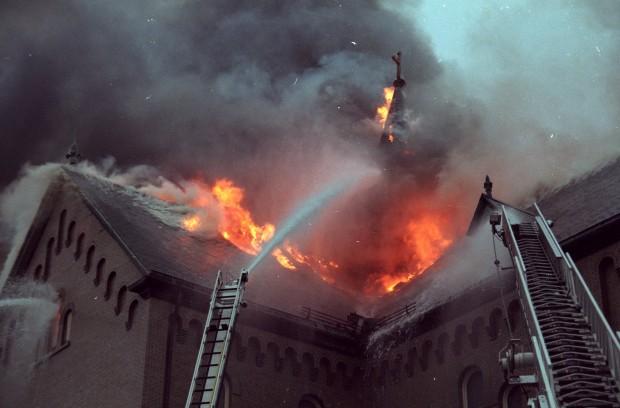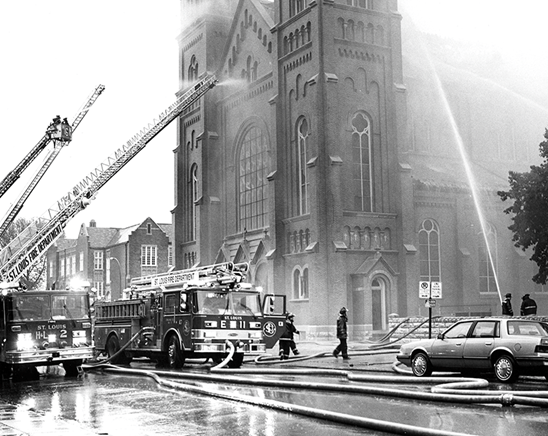The Fire at the Church
August 9, 2019

Firefighters attempt to extinguish the blazing roof of St. Anthony of Padua Catholic Church in St. Louis on April 28, 1994. (Renyold Ferguson/Post-Dispatch)
ALAN writes:
When I learned that the roof of Notre Dame Cathedral had burned, it reminded me of two other events in south St. Louis from long, long ago.
Sometime in or around 1959, I was awakened by a thunderstorm in the middle of the night. All of us were asleep. Upon awakening, I glanced in the direction of our bathroom and saw that the light was on. That puzzled me because I knew no one could be in there. I awakened my mother and she got up to investigate. Indeed no one was there, but the ceiling light had come on and puffs of smoke were emerging from the light fixture. She immediately called the fire department and men arrived within a few minutes. One or more of them climbed onto the roof to assess the situation. They concluded that lightning struck the roof and caused the light to come on. They made sure that there was no potential for fire. In the middle of the night and during an intense thunderstorm, it all seemed rather scary to a 10-year-old boy. Of course we were extremely fortunate.
I was attending St. Anthony of Padua parochial school in those years. One of my classmates was a boy named Larry, whose family lived a few houses down from ours. We often played baseball at Marquette Park, two blocks away. I remember a day in October 1958 when Larry and I walked to school together and talked about a spooky TV program we had watched the night before, called “The House of Flying Objects”. (It should have been called “The House of Teenage Pranksters”.) Larry’s father was a firefighter.
Roughly 35 years later, another thunderstorm occurred in south St. Louis early one morning in April 1994. Lightning struck the roof of a building one block from the modern apartments where my mother was then living. No one was hurt. But the lightning started a fire that destroyed the roof of St. Anthony of Padua church—the church my mother attended for more than half her life, the church where Larry and I had been altar boys during our school years.
My mother learned about the fire when a friend and neighbor telephoned her. She left her apartment and walked two blocks to an intersection on Meramec Street where many people were standing in the rain and watching firemen working to control and extinguish the fire. At that moment she did not know that one of those men was my old classmate Larry, who had by then become a captain in the St. Louis Fire Department, following in the line of work chosen by his grandfather, father, and older brother.
“Oh, we cried when we saw this,” one woman said as she stood there in that crowd. She had been married in the church. “It’s still unbelievable. This church is why we are still in this neighborhood.”
NiNi Harris is a lifelong resident of south St. Louis, writer, and historian. She has led many neighborhood walking tours. Her name comes from how she pronounced Eileen when she was an infant. She has a passionate attachment to St. Louis history. One day a friend and I were coming out of an antique shop when who should we meet walking toward us but NiNi and one of her tour groups trailing behind her. If the city of St. Louis were run by people with any sense (as likely to happen as my becoming the first astronaut to land on Pluto), they would declare her a civic treasure.
On that morning in 1994, NiNi and her mother stood there in that crowd watching the fire. “What an impressive church and what a heart-wrenching scene,” she wrote afterwards. “The flames were obliterating 130 years of history.”
As the fire raged, “we joined a circle of hundreds of parishioners and neighbors watching quietly. The circle—several blocks in diameter—ringed an army of firemen, firefighting equipment, a huge web of hoses, and the flaming church at the center. The people kept a vigil as the flames engulfed more and more of the roof”, not knowing whether the firefighters would gain control of the fire before it destroyed the church.
More than a hundred men were there and they had the fire under control within an hour. Only the roof was destroyed. The walls were not damaged or weakened, and the altar and the stained glass windows were mostly intact. Damage to the interior was caused less by the fire itself than by all the water poured on it. Hours after the fire was out, water was still flowing out the front doors and down the steps of the church.
It could have been much worse. That it wasn’t was a credit to the superlative skill and determination of those firefighters. NiNi Harris called it “Miracle on Meramec Street”.
My mother carried her camera with her that morning, but the film in the camera had only one picture left on it. It was the last picture she would take in her life. It shows the church on fire, clouds of smoke, long hoses in the middle of the street, the rectory building next to the church, and the wide sidewalk extending the length of that block.
On a Saturday morning 35 years earlier, she stood at that same corner and took pictures as my classmates and I walked along Meramec Street in our school’s picnic day parade. It was the same corner and streetscape that we had come to know so well since the days in 1958 when she, my grandfather, and I walked through Marquette Park to Sunday morning Mass in that church, and since all the days when I walked to school and stopped at the neighborhood bakery on Meramec Street before my classmates and I attended Mass every school-day morning.
It was the church where the traditional Latin Mass had been the norm in the 1950s; where I gazed at murals high on the interior walls during Mass on hot Sunday mornings in 1958-‘59 when women fanned themselves with handheld cardboard fans; where my classmates and I climbed a staircase leading to the sacristy where we hung our coats and put on our cassock and surplice before serving at Mass, and where we waited in line at one of the ornately carved wooden confessionals; where I served one year at Christmas Midnight Mass, when the church was lighted more brightly than I had ever seen; where I purchased magazines like Sign, Catholic Digest, or U.S. Catholic with nickels and dimes from a magazine rack in the church’s vestibule in 1965; where parishioners leaving the church after Sunday morning Mass could purchase brown paper bags of soft pretzels from boys on the sidewalk outside; and where I stood in the silence and lingered for half an hour one day in 2008, remembering, thinking, regretting, standing near sections of the pews where the three of us would sit on all those Sunday mornings 50 years earlier, and where I lit five candles in memory of my parents, grandparents, and extended family, and where I paused before leaving to contemplate the fragment of a huge bell that was now in the back of the church but had been in the roof when it burned on that morning in 1994 and that those firemen had saved from complete destruction.
Even now, a quarter century after the day of that fire, it is heart-wrenching for me to remember all those things as I sit here writing these words.
The church had been “a focal point in the lives of hundreds of thousands of people over its 84-year existence,” NiNi Harris wrote. “Even those who were not Catholic had taken advantage of the serenity of simply sitting inside this magnificent structure when they felt troubled.”
Every word she wrote was true. [I have quoted her remarks from her essay included in the booklet Rebuild My Church, published by St. Anthony of Padua Church in 1996.]
Within two years, the roof had been rebuilt and the church reopened. (More photos of the church and neighborhood can be seen here.) My father took several dozen pictures during the months-long rebuilding of the roof. So expert was the restoration and rebuilding that people who walk into the church for the first time might not even believe a fire had occurred there. That was a wonderful achievement—in the material realm. The tragic irony lies in the metaphysical realm, the realm wherein churches like St. Anthony’s had seen and would continue to see greatly diminished parish populations concurrent with radical changes made within the Catholic Church over the past half century and its accommodation of equally radical changes in the culture at large.
That church and the neighborhood it once anchored can never be what they were in the 1950s, because there are no 1950s people there anymore.



